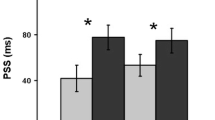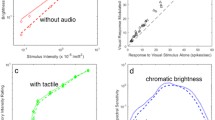Abstract
Some common features of neural transformations along sensory pathways are discussed. The emphasis is on spatial mapping in the visual system, but close parallels exist in temporal visual mapping as well as other sensory systems. The role played by lateral inhibition in sequential transformations is investigated by direct computation and by mathematical analysis.
Similar content being viewed by others
References
Arden, G. B.: Types of response and organization of simple receptive fields in cells of the rabbit's lateral geniculate body. J. Physiol. (Lond.) 166, 449 (1963).
Attnaeve, F.: Informational aspects of visual perception. Psychol. Rev. 61, 183 (1954).
Barlow, H. B.: Action potentials from the frog's retina. J. Physiol. (Lond.) 119, 58 (1953a).
— Summation and inhibition in the frog's retina. J. Physiol. (Lond.) 118, 69 (1953b).
— Three points about lateral inhibition. In: Sensory communication (W. A. Rosenblith, ed.). New York: Wiley & Sons, Inc. 1961.
Baumgartner, G., Brown, J. L., Schulz, A.: Responses of single units of the cat visual system to rectangular stimulus patterns. J. Neurophysiol. 28, 1 (1965).
Beek, B.: Analysis of receptive fields of vertebrate retina by computer simulation. Dissertation, Syracuse University, Syracuse, N.Y. 1970.
Békésy, G. v.: Neural funneling along the skin and between inner and outer haircells of the cochlea. J. acoust. Soc. Amer. 31, 1236 (1959).
— Neural inhibitory units of the eye and skin. Quantitative description of contrast phenomena. J. opt. Soc. Amer. 50, 1060 (1960).
Burns, B. D.: The mammalian cerebral cortex. London: Edward Arnold, Ltd. 1958.
Creutzfeldt, O., Lux, H. D., Nacimiento, A. C.: Intracelluläre Reizung corticaler Nervenzellen. Pflügers Arch. ges. Physiol. 281, 129 (1964).
Eccles, J. C.: Cerebral synaptic mechanisms. In: Brain and conscious experience (J. C. Eccles, ed.). Berlin-Heidelberg-New York: Springer 1966.
Fuortes, M. G. F.: Electrical activity of the cells of limulus. Amer. J. Ophthal. 46, part II, 210 (1958).
— Initiation of impulses in visual cells of limulus. J. Physiol. (Lond.) 148, 14 (1959).
Fuster, T. M., Herz, A., Creutzfeldt, O. D.: Interval analysis of cell discharge in spontaneous and optically modulated activity in the visual system. Arch. ital. Biol. 103, 159 (1965).
Granit, R.: Receptors and sensory perception. New Haven: Yale Univ. Press 1962.
— Kernell, D., Shortess, G. K.: Quantitative aspects of repetitive firing of mammalian motoneurons, as caused by injected currents. J. Physiol. (Lond.) 168, 1911 (1963).
Harth, E., Beck, B., Pertile, G., Young, F.: Signal stabilization and noise suppression in neural systems. Kybernetik 7, 112 (1970).
Hartline, H. K.: Inhibition of activity of visual receptors by illuminating nearby retinal areas in the limulus eye. Fed. Proc. 8, 69 (1949).
Hubel, D. M., Wiesel, T. N.: Receptive fields of single neurons in the cat's striate cortex. J. Physiol. (Lond.) 148, 574 (1959).
— Integrative action in the cat's lateral geniculate body. J. Physiol. (Lond.) 155, 385 (1961).
Katsuki, Y.: Neural mechanism of auditory sensation in cats. In: Sensory communication (W. A. Rosenblith, ed.). New York: John Wiley & Sons, Inc. 1961.
Kuffler, S. W.: Neurons in the retina; organization, inhibition and excitation problems. Cold Spr. Harb. Symp. quant. Biol. 17, 281 (1952).
— Discharge patterns and functional organization of mammalian retina. J. Neurophysiol. 16, 37 (1953).
Mach, E.: Über die physiologische Wirkung räumlich verteilter Lichtreize. S.-B. Akad. Wiss. Wien, math.-nat. Kl. 54, Abt. 2, 393 (1866).
Mountcastle, V. B., Powell, T. P. S.: Neural mechanisms subserving cutaneous sensibility, with special reference to the role of afferent inhibition in sensory perception and discrimination. Bull. Johns Hopk. Hosp. 105, 201 (1959).
Perkel, D. H., Bullock, T. H.: Neural coding. Neurosci. Res. Prog. Bull. 6, 221 (1968).
Pertile, G., Harth, E.: A model of adaptation based on relaxation phenomena in the neural membrane. Kybernetik 9, 189–195 (1971).
Ratliff, F.: Inhibitory interaction. In: Sensory communication (W. A. Rosenblith, ed.). New York: Wiley & Sons, Inc. 1961.
— Mach bands: quantitative studies on neural networks in the retina. Pages 132ff. San Francisco, London and Amsterdam: Holden-Day, Inc. 1965.
Sherrington, C. S.: The integrative action of the nervous system. New York: Scribner 1906.
Author information
Authors and Affiliations
Rights and permissions
About this article
Cite this article
Harth, E., Pertile, G. The role of inhibition and adaptation in sensory information processing. Kybernetik 10, 32–37 (1972). https://doi.org/10.1007/BF00288781
Received:
Issue Date:
DOI: https://doi.org/10.1007/BF00288781




